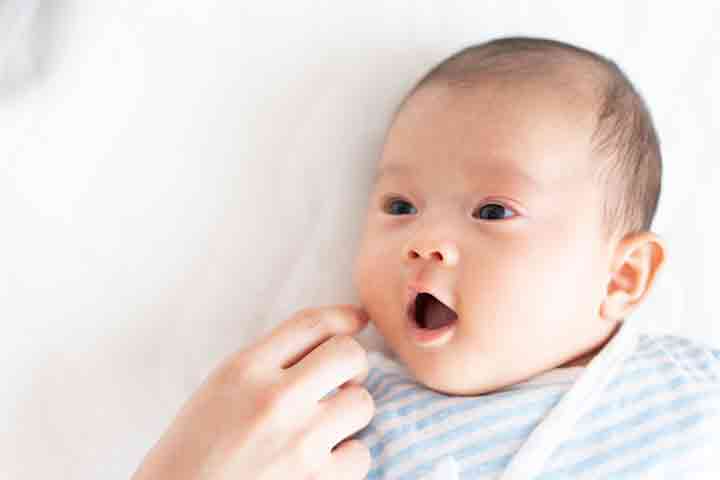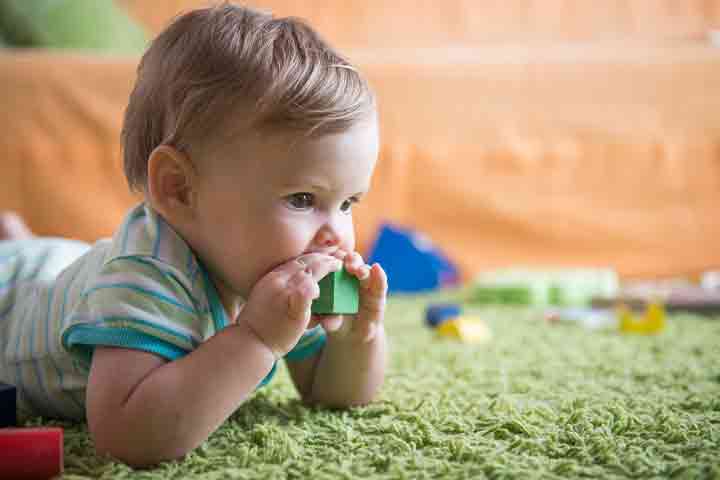The rooting reflex in babies is one of the primitive reflexes, which help them transition smoothly into the new environment outside the womb. All reflexes are controlled by the central nervous system (CNS) and are triggered only by the right stimulus. Be it holding the finger or sticking the tongue out; these reflexes are critical tools to assess a baby’s nervous system function and overall development (1).
Learn more about the rooting reflex, its significance for babies, and why the absence of rooting reflex is cause for concern.
What Is A Rooting Reflex?
The rooting reflex is an innate, involuntary response triggered when the corner of the baby’s mouth is touched or stroked. In response, the baby turns the head towards the direction of the touch, opens the mouth, and thrusts the tongue out. This primitive motor reflex is crucial for a baby’s survival as it helps them find their source of food, whether it be a breast or bottle nipple.
The reflex may also trigger when the baby’s cheeks are stroked (2). Initially, a baby may search for the stimulus (the nipple) by moving their head side to side, turning towards the nipple, and then away from it. Once breastfeeding or bottle-feeding is established in three to four weeks, they turn and find the nipple easily (3).
Other Primitive Reflexes
Babies have the following newborn reflexes apart from the rooting reflex.
- Sucking reflex
- Moro or startle reflexiXA reflex where babies are startled by sudden noise or movement, throwing back their heads and spreading their limbs
- Palmar grasp reflexiXAn involuntary action in which the baby’s palm closes when an object is placed inside
- Stepping reflexiXAn action when the baby tries to walk or dance in an upright position
- Plantar reflexiXA reflex movement occurring from tickling or stroking the toes of a baby
- Tonic labyrinthine reflexiXA primitive reflex in which the movement of the head and limbs are synchronized, causing babies to straighten and bend them together
- Asymmetrical tonic neck reflex (ATNR)
- Symmetric tonic neck reflex (STNR)iXA primitive reflex that helps babies to move the upper and lower parts of their body independently, allowing them to learn to crawl
- Galant reflexiX An abdominal reflex in newborns that causes babies to curve their hips outwards by lying on their stomachs
- Parachute reflex
When Does Rooting Reflex Appear?
The rooting reflex develops in the womb around 28 weeks of pregnancy (4). This reflex is innate in all infants at birth. Some premature babies may have an underdeveloped or absent rooting reflex. In such cases, the mother may guide the baby towards the nipple during breastfeeding.
How To Test For Rooting Reflex In Babies?
You may test for rooting reflex by gently stroking the corners of the baby’s mouth. You may also stroke their cheeks. The baby will turn their head in the direction of the touch, open their mouth, and stick their tongue out as if ready to feed (4).
How Is Rooting Different From Sucking?
Both rooting and sucking reflexes are essential for a baby to feed; however, they serve different functions. The rooting reflex helps the baby find the nipple, and the sucking reflex helps them ingest the milk.
The rooting reflex starts when the corners of the baby’s mouth are stimulated, while the sucking reflex is activated when the nipple touches the baby’s palate (roof of the mouth). Once the nipple touches the baby’s palate, they begin feeding.
The sucking reflex temporarily suspends breathing during swallowing to prevent food from entering the airways. The reflex initiates in the womb at the 32nd week and needs about 36 weeks to manifest fully (5).
How Long Does Rooting Reflex Last?
The rooting reflex lasts for up to four to six months. By this age, the frontal lobe of the cerebral cortex develops, causing reflex inhibition. Instead, babies begin to voluntarily turn their heads towards the food source without searching for it.
Does The Rooting Reflex Indicate Hunger?
A baby may be hungry if they display a rooting reflex when the corners of their mouth are stroked with fingers (6). It is important to note that this behavior is based on instinct and may not always accurately indicate hunger in every baby.
It is good to note and ascertain the other hunger cues before initiating feeding. Here are a few notable signs of hunger in babies (7) (8).
- Sucking action or noise
- Putting fists or other objects in the mouth
- Tightly holding the fists over stomach or chest
- Smacking the lips
- Opening and closing the mouth
- Stretching and flexing arms and legs often
When To Seek Help?
Consult a pediatrician if the rooting reflex persists beyond the age of six months. The persistence of the reflex may suggest problems with reflex integration, a process where higher brain centers inhibit primitive reflexes and turn them into voluntary actions (9).
Several neurological issues, such as cerebral palsyiXA group of disorders that affects movement and posture and is usually caused due to abnormal brain development before birth and trigeminal cranial nerve dysfunctioniXA chronic pain affecting the nerve responsible for providing sensation from the face to the brain, may lead to the persistence of the rooting reflex (4). The baby may also display the following signs of possible neurological issues.
- Protrusion of the tongue, leading to swallowing difficulties
- Excess drooling due to poor mouth control
- Speech problems
- Uneven gait
- Increased muscle tone (hypertonia) or decreased muscle tone (hypotonia)
- Delay in achieving developmental milestones
The pediatrician may ask you to wait for a couple of weeks if the baby has no other developmental delay and is overall healthy. If the doctor suspects a possible neurological issue, relevant diagnostic steps and treatments may be suggested.
The rooting reflex is present in every newborn that helps to find the nipple during the initial days of breastfeeding. It may also be used to check the baby’s hunger. However, the reflex starts to recede after four or six months. This is because the development of the cerebral cortex after this age enables them to find the feeding source without any reflex. Therefore, after six months of age, the presence of the rooting reflex may indicate underlying neurological issues. Hence, if you notice an abnormal reflex or if it persists beyond six months, visit your pediatrician for a checkup.
Key Pointers
- Rooting reflex is a primitive, involuntary motor reflex that helps a baby find its food, i.e., breast or bottle nipple.
- It develops around 28 weeks of pregnancy and disappears by four to six months after birth.
- If the reflex persists beyond six months, it may indicate an underlying neurological issue such as cerebral palsy.
- Protrusion of the tongue, increased or decreased muscle tone, and excessive drooling are a few signs of a possible neurological issue.
Watch this video to learn about the amazing rooting reflex in babies! See how babies turn their heads to find a nipple and how this reflex helps them feed.















